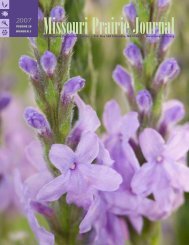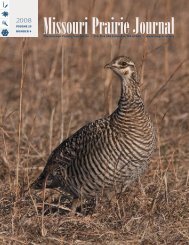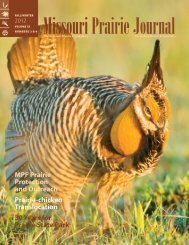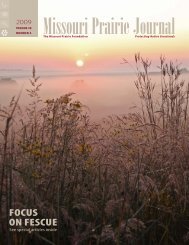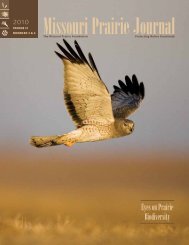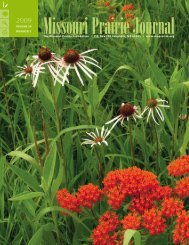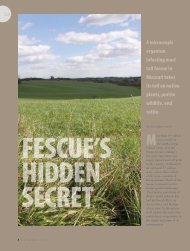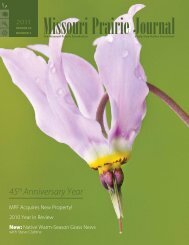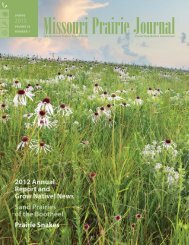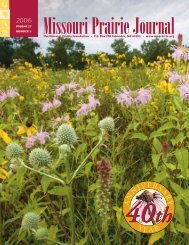Fall 2007: Volume 28, Number 4 - Missouri Prairie Foundation
Fall 2007: Volume 28, Number 4 - Missouri Prairie Foundation
Fall 2007: Volume 28, Number 4 - Missouri Prairie Foundation
You also want an ePaper? Increase the reach of your titles
YUMPU automatically turns print PDFs into web optimized ePapers that Google loves.
<strong>Foundation</strong>the formation of the Grasslands Coalition (GC). GC partners—QuailUnlimited, the Society for Range Management, state agencies, Audubon<strong>Missouri</strong>, The Nature Conservancy, and many other groups—pool resourcesand expertise to maximize positive impacts on prairie conservation.One of the GC’s first steps was to identify core areas of the state thatwere strongholds for state-endangered greater prairie-chickens and thebest places to invest limited resources to protect and restore grasslandhabitat. These areas, called Grasslands Coalition Focus Areas, contain publicland owned by the <strong>Missouri</strong> DepartmentThe Grasslands Coalition of Conservation, the Department of NaturalResources, MPF, The Nature Conservancy andhas always appreciatedland owned by private citizens maintained ashow important cropland native prairie, pasture or cropland.and well managedThe GC has always appreciated howimportant cropland and well managed pasture arepasture are to the future to the future of grassland wildlife. Together withof grassland wildlife. species-rich prairie, working lands are a criticallyimportant part of the habitat matrix that canTogether with speciesrichprairie, working lands species. The GC also recognizes the economicsupport grassland birds and other prairie-adaptedare a critically important realities that come with making a living fromthe land and wants to work with landowners topart of the habitatimprove habitats in mutually beneficial ways.matrix that can support The GC has secured millions of dollars ofgrassland birds and otherfunding for prairie restoration, control of invasivespecies and acquisition of land for prairie wildlife.This funding has been used on public landprairie-adapted species.and also given to private landowners interestedin improving prairie habitat on (or selling) theirland. A summary of accomplishments of the GC for greater prairie-chickenrecovery efforts in fiscal year <strong>2007</strong> is on page 26.In 2005, MDC was called upon by the U.S. Fish and Wildlife Service toidentify the best places in the state that meet the needs of wildlife, to preventthe federal listing of any more plants or animals as threatened or endangered.As part of this Comprehensive Wildlife Strategy, MDC designated GrasslandConservation Opportunity Areas as the best places in the state to conserveprairie wildlife—these COAs include or are associated with GrasslandsCoalition Focus Areas.Today, MPF is exploring additional ways to help both private landownersmaking a living off of their land and prairie wildlife. The articles on thecarbon market and the Show Me Energy Cooperative that follow in thisissue, and articles in the same vein that will appear in future issues, explorewhat could be coined the Tallgrass <strong>Prairie</strong> Economy—economic opportunitiesavailable from high quality grasslands to people living in them.Carol Davit is the Journal editor.Frank OberleAt the time of European settlement, at least 15 millionacres—more than one-third—of <strong>Missouri</strong>’s landscapewas tallgrass prairie (see orange, above). Fewer than90,000 acres of tallgrass prairie remain today. Morethan 800 different kinds of plants can be found on<strong>Missouri</strong>’s prairies, which also support countlessspecies of birds, insects, mammals and other wildlife.Healthy native grasslands may hold promise for ourown economic benefit as well.Walter Schroeder





